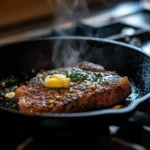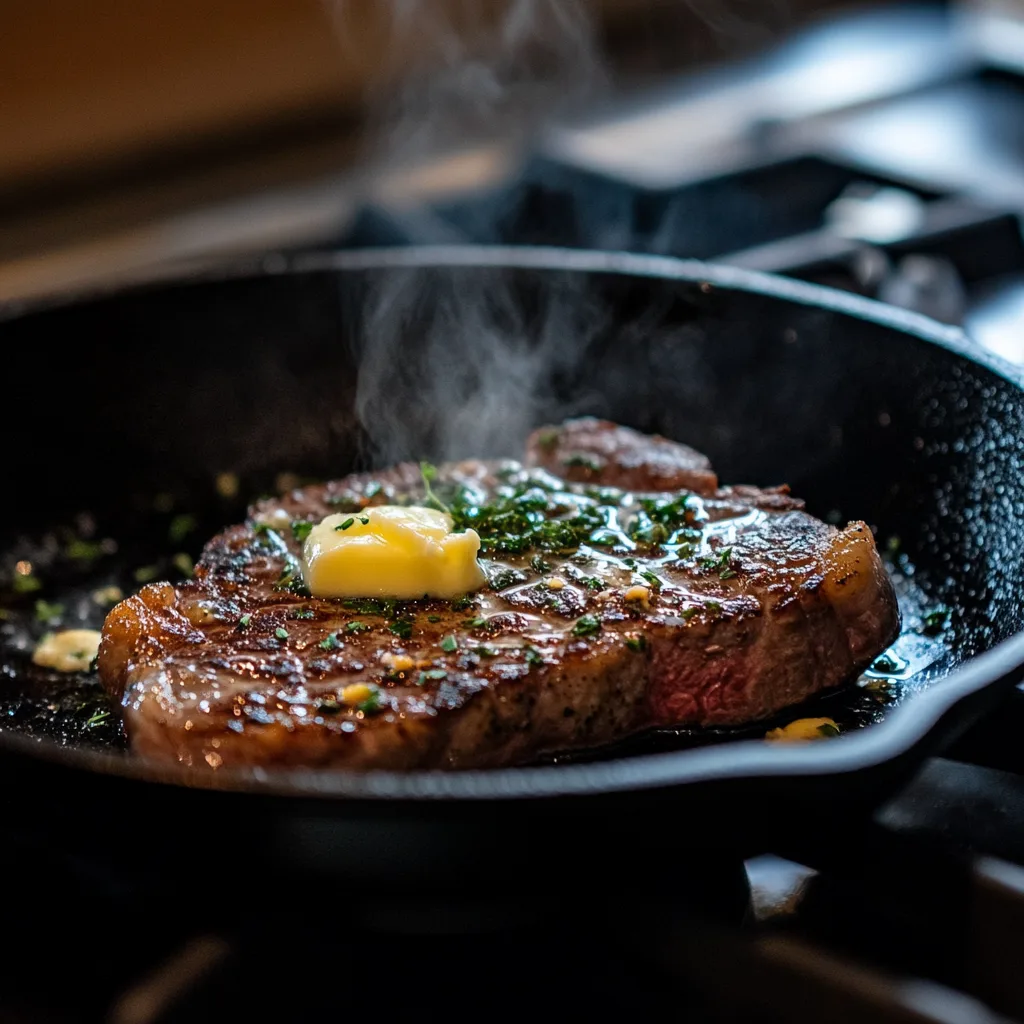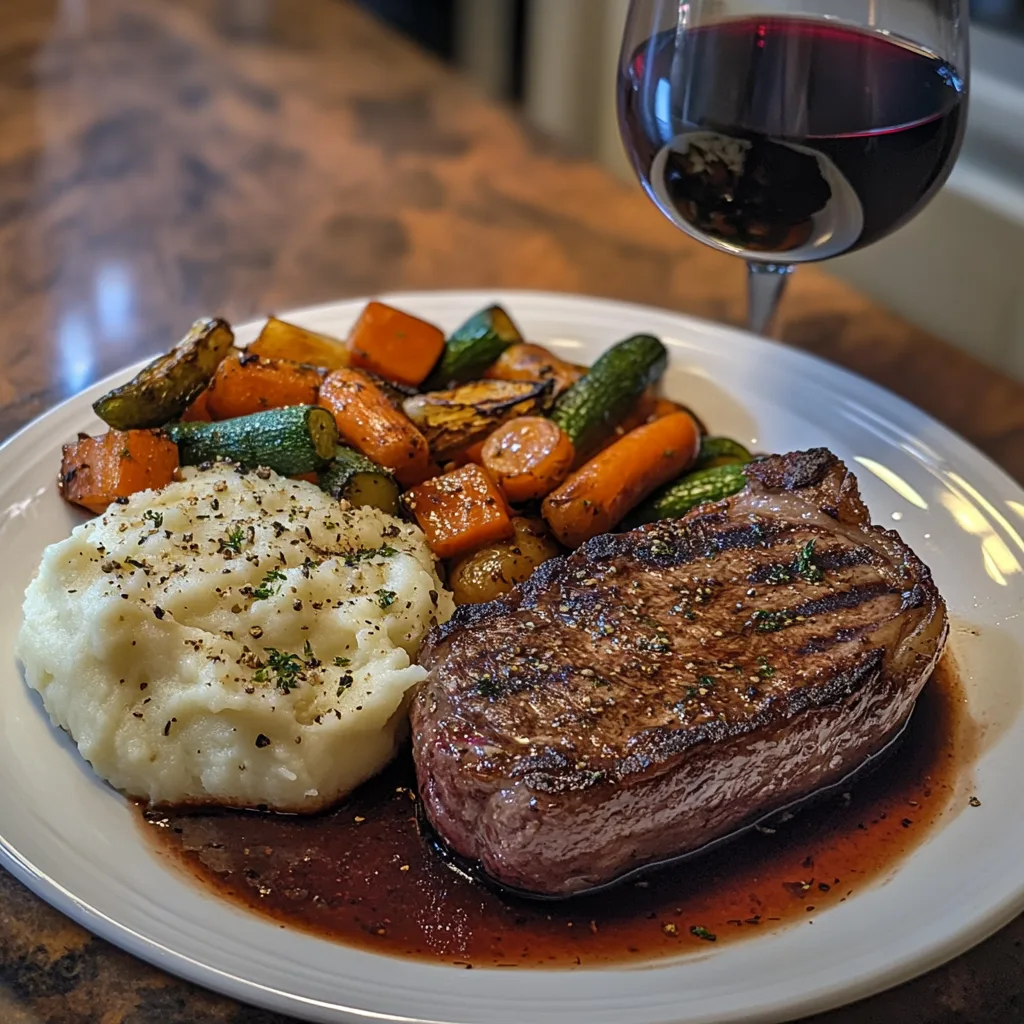Cooking steak perfectly every time might sound impossible—unless you’ve tried sous vide ribeye steak. This slow-water immersion technique allows home cooks and professionals alike to deliver restaurant-quality results without breaking a sweat. No more overcooked edges or raw centers. Instead, you get juicy, flavorful beef with consistent doneness from edge to edge.
In this guide, you’ll learn everything you need to master the sous vide method for ribeye. From selecting the right cut and setting the ideal temperature to achieving the perfect sear, this article covers it all. Plus, we’ll answer your top questions about sous vide timing, temperature control, and Anova settings.
Tools You’ll Need to Get Started (Anova, bags, cast iron)
Looking for inspiration? Try this expert guide on cooking bone-in sirloin steak to compare techniques and meat textures.
Print
Sous Vide Ribeye Steak – The Best Foolproof 2-Hour Method
- Total Time: 2 hours 10 minutes
- Yield: 2 servings 1x
Description
Sous vide ribeye steak delivers perfect doneness every time. Learn the best time, temp & searing tips for a juicy, flavorful steak at home.
Ingredients
- 2 boneless ribeye steaks (1.5 to 2 inches thick)
- Kosher salt, to taste
- Freshly ground black pepper, to taste
- 2 cloves garlic (crushed)
- 2 sprigs rosemary or thyme
- 2 tablespoons unsalted butter (optional)
- Avocado oil or grapeseed oil (for searing)
- Vacuum-seal bag or freezer-grade Ziploc
Instructions
1. Preheat your sous vide circulator to 130°F for medium-rare.
2. Pat steaks dry and season both sides with salt and pepper.
3. Add crushed garlic and herbs on top. Optionally, add butter.
4. Seal steaks in vacuum bags or use water displacement method with Ziploc.
5. Place in preheated water bath and cook for 2 hours (adjust for thickness).
6. Once done, remove from bag and pat dry with paper towels.
7. Preheat a cast iron skillet until very hot.
8. Sear steak for 30–45 seconds per side, basting with butter if desired.
9. Let rest for 2–3 minutes. Slice and serve.
Notes
Use a cast iron skillet or torch to create a crisp crust after sous vide. For best flavor, use USDA Prime beef and rest the steak both before and after searing.
- Prep Time: 10 minutes
- Cook Time: 2 hours
- Category: Main Course
- Method: Sous Vide
- Cuisine: American
Nutrition
- Serving Size: 1 steak
- Calories: 550
- Sodium: 600mg
- Fat: 40g
- Protein: 48g
- Cholesterol: 130mg
Keywords: sous vide ribeye, sous vide steak, ribeye steak recipe, sous vide beef, steak sous vide method
Why Sous Vide Ribeye Steak Is a Game Changer
What makes sous vide different from traditional grilling or pan-searing?
Sous vide (French for “under vacuum”) is a cooking technique that slowly brings food to temperature in a water bath. This ensures the internal temperature of your ribeye steak is precisely controlled—down to the degree.
Unlike pan-searing or grilling, which can leave the inside underdone and the outside overdone, sous vide guarantees uniform cooking throughout. No guesswork, no poking the meat, and no dry patches.
Here’s a quick comparison table:
| Cooking Method | Consistency | Flavor Retention | Crust Potential |
|---|---|---|---|
| Grilling | Medium | Medium | Excellent |
| Pan-searing | Medium | Medium | Excellent |
| Sous vide + sear | High | High | Excellent |
In sous vide, your steak is vacuum-sealed and cooked in water at your target temp (e.g., 130°F for medium-rare). This allows it to reach perfect doneness all the way through—then you just finish with a high-heat sear.
Why ribeye is the ideal cut for sous vide cooking
Ribeye steaks are rich in marbling (those beautiful white lines of fat). This marbling makes the ribeye tender, flavorful, and well-suited to long, low-temperature cooking like sous vide. The fat slowly renders over time, infusing the meat with deep flavor and buttery texture.
Additionally, sous vide gives ribeye time to tenderize without losing juices. With conventional methods, there’s always the risk of drying it out. But with sous vide, your ribeye retains everything—flavor, moisture, and that satisfying bite.
Bonus Tip: Choose a thick-cut ribeye (1.5 to 2 inches) for best sous vide results. Thinner cuts cook too quickly and don’t benefit as much from this method.
Don’t miss our guide to teres major steak—a lesser-known but incredibly tender alternative to ribeye.
Choosing the Right Ribeye for Sous Vide
Bone-in vs. boneless ribeye: What’s better for sous vide?
When it comes to sous vide, both bone-in and boneless ribeye cuts can deliver stellar results—but there are a few differences worth noting.
Boneless ribeye is the most common choice. It’s easier to bag, vacuum seal, and cook evenly since there’s no bone to affect the heat distribution. If you’re new to sous vide, start here. It’s also quicker to sear post-bath due to its even thickness.
On the other hand, bone-in ribeye brings an added depth of flavor thanks to marrow and connective tissues near the bone. However, it requires more precision in searing and sealing. The bone can sometimes interfere with vacuum sealing, creating air gaps that may float in the bath.
| Feature | Boneless Ribeye | Bone-in Ribeye |
|---|---|---|
| Ease of Cooking | Easier to vacuum & cook | Slightly trickier (bone structure) |
| Flavor | Rich | More intense, meaty flavor |
| Presentation | Classic steakhouse cut | Eye-catching and premium |
If you’re aiming for flavor depth and a dramatic presentation—go bone-in. But if you want easier handling and quicker prep, boneless is your best bet.
Check out this smoked bacon-wrapped meatloaf recipe for another delicious way to explore deep, beefy flavors with a slow-cooking method.
Grading matters: USDA Prime, Choice, and Select explained
Not all ribeyes are created equal. The USDA grades beef based on marbling and maturity, which directly impact how juicy and flavorful your steak turns out.
Here’s what to look for when selecting a ribeye for sous vide:
| USDA Grade | Marbling Level | Flavor & Juiciness | Sous Vide Suitability |
|---|---|---|---|
| Prime | Highest | Rich, buttery, juicy | ★★★★★ |
| Choice | Moderate | Well-balanced | ★★★★☆ |
| Select | Leaner | Less tender/juicy | ★★☆☆☆ |
Pro tip: Look for USDA Prime if possible. It holds up beautifully during longer cooking and gives you that buttery, melt-in-your-mouth finish. If you go with Choice, aim for thicker steaks with visible fat striations.
Want a wild alternative to beef? Discover our flavorful venison cube steak recipe for a leaner sous vide experience.
Best Temperature and Time Settings for Sous Vide Ribeye Steak

Perfect sous vide temperature chart for ribeye doneness
One of the best features of cooking sous vide is total control over doneness. Whether you prefer your ribeye rare and juicy or well-done and firm, sous vide allows you to lock in the texture and temperature with precision.
Here’s a go-to temperature chart for ribeye steak doneness:
| Doneness | Temperature (°F) | Texture & Notes | Time (1–2 inch thick) |
|---|---|---|---|
| Rare | 122–128°F | Very red center, soft texture | 1–2.5 hours |
| Medium-Rare | 129–134°F | Bright red/pink center, tender and juicy | 1–3 hours |
| Medium | 135–144°F | Warm pink center, firm and juicy | 1–4 hours |
| Medium-Well | 145–155°F | Slight pink, firmer bite | 1–4 hours |
| Well-Done | 156°F+ | Fully cooked, dense texture | 1–4 hours |
Recommended: For most steak lovers, 129–134°F (Medium-Rare) delivers that classic steakhouse feel—tender, juicy, and buttery-soft.
If you’re using the Anova Precision Cooker, simply set your desired temp via the app or manually dial it in. Anova’s precision makes it ideal for managing longer cook times while maintaining consistent results.
How long to sous vide a 1-inch vs 2-inch ribeye steak
Cook time depends heavily on thickness. A thinner 1-inch ribeye only needs about 1 to 1.5 hours. Thicker steaks, like 2 inches, need 2 to 3 hours to fully reach internal temp and maximize tenderness.
Quick Reference:
- 1-inch steak: 1 to 1.5 hours
- 1.5-inch steak: 1.5 to 2.5 hours
- 2-inch steak: 2 to 3 hours
For thicker cuts, don’t rush. Time doesn’t overcook sous vide steak, but going under will leave the center slightly cool or underdone.
Learn more about technique comparisons in this guide to seared ahi tuna, another precision-cooked protein that thrives under temperature control.
Pro Tip: While you can leave your ribeye in the bath longer (up to 4 hours), doing so beyond that starts to break down muscle fibers too much, creating a mushy texture.
Step-by-Step Process to Sous Vide a Ribeye Steak
Prepping the ribeye: Seasoning, bagging, and vacuum sealing
These FoodSaver bags are perfect for sous vide and freezer-safe.
The key to a flavorful sous vide ribeye begins with proper prep. Since sous vide doesn’t caramelize flavors during cooking like grilling does, seasoning matters—a lot.
Here’s how to prep your ribeye:
- Pat the steak dry with paper towels. Moisture reduces sear quality.
- Generously season with kosher salt, black pepper, and garlic powder. You can also add rosemary, thyme, or a sprig of fresh oregano for aromatics.
- Optional Additions: A thin slice of butter or a clove of smashed garlic in the bag can elevate flavor.
- Place in vacuum-seal bag or use a freezer-grade Ziploc with the water displacement method.
| Item | Purpose |
|---|---|
| Salt & pepper | Basic flavor and crust build-up |
| Garlic/herbs | Subtle aroma infusions |
| Butter or ghee | Moisture + flavor enhancer |
| Vacuum-seal bag or Ziploc | Airtight, water-safe cooking |
Tip: Avoid overly acidic marinades pre-sous vide—they can break down the meat too much during longer cook times.
Looking for flavor-packed seasoning tips? Discover great ideas like our pink salt recipe for weight loss that can double as a unique rub.
Sous vide setup: Using Anova or other circulators
We recommend this Anova Nano for consistent, beginner-friendly cooking.
Once your steak is sealed and ready, it’s time to set up your water bath. Whether you’re using Anova, Joule, or another immersion circulator, the steps are nearly identical:
Steps to Cook:
- Fill a large pot or container with hot tap water.
- Attach your sous vide circulator (e.g., Anova) and set your desired temp (e.g., 130°F for medium-rare).
- Place sealed ribeye into water. Make sure it’s fully submerged. Use clips or a weight if needed.
- Cook for 1.5 to 3 hours depending on thickness.
Equipment Checklist:
- Anova or other circulator
- Pot or food-grade container
- Clip or sous vide weight
- Timer (or use the app!)
Once time is up, your ribeye will look gray—not to worry! That’s normal. The magic happens during the final sear.
Check out this guide on the ultimate burger bowl for a unique pairing idea that complements a sous vide steak beautifully.
Searing Your Sous Vide Ribeye to Perfection
We love using this cast iron skillet for a deep, caramelized crust.
Why searing matters after sous vide
Your sous vide ribeye is fully cooked at this point—but it’s not done. It needs that crispy, caramelized crust that makes steak so irresistible. That’s where the Maillard reaction comes in—a chemical process that creates that golden-brown finish and deep, savory flavor.
Without this quick, hot sear, your steak might taste fine but look dull and lack the bold flavor you expect from a restaurant-style ribeye.
Important: Sear quickly and hot. You only want to brown the outside—not cook it further.
Best methods to sear: Cast iron, torch, or grill
There are several excellent searing options, and each adds its own flair. Let’s explore the top three:
1. Cast Iron Skillet (Best All-Around)
- Preheat your skillet until smoking hot.
- Add high smoke-point oil (like avocado or canola).
- Sear steak for 30–45 seconds per side.
- Optional: Add butter, garlic, and thyme for last 15 seconds to baste.
2. Propane or Butane Torch
- Ideal for quick, even browning.
- Use sweeping motions to avoid burning one spot.
- Finish with cast iron for a crust boost if needed.
3. Outdoor Grill
- Preheat grill to maximum heat.
- Sear each side directly over flame.
- Best for smoky flavor and grill marks.
| Searing Tool | Crust Quality | Flavor Impact | Best Use Case |
|---|---|---|---|
| Cast Iron | Excellent | Deep, beefy | Indoor cooking |
| Torch | Moderate | Smoky/savory | Spot browning + detail |
| Grill | Excellent | Charred, smoky | Outdoor or BBQ prep |
Don’t forget to rest the steak for 3–5 minutes post-sear to redistribute juices.
For searing inspiration, don’t miss our smoker recipe guide to learn how heat affects proteins and enhances flavor depth.
Advanced Flavor Tips and Butter Basting
Using compound butter or aromatics in the sous vide bag
While sous vide locks in natural juices and tenderness, you can boost the flavor even more by adding aromatics and compound butters during the cook.
Try adding these to your sous vide bag:
- Compound butter: Mix softened butter with garlic, parsley, lemon zest, or truffle salt
- Fresh herbs: Sprigs of thyme, rosemary, or oregano
- Garlic cloves: Lightly crushed for subtle infusion
- Shallots: Thin slices for a mellow, sweet finish
These additions melt slowly into the meat, infusing it from the inside out over hours in the water bath.
How to make basic garlic herb compound butter:
| Ingredient | Amount |
|---|---|
| Unsalted butter | ½ cup (softened) |
| Garlic (minced) | 2 cloves |
| Fresh parsley | 1 tbsp (chopped) |
| Lemon zest | 1 tsp |
| Salt & pepper | To taste |
Mix all, roll into a log in parchment paper, chill, and slice into rounds to place over your steak post-cook.
Post-sous vide butter basting for steakhouse-level flavor
After searing, you can take your ribeye to another level with a final butter baste. This technique—common in high-end steakhouses—adds richness and a glossy finish.
Quick butter-basting steps:
- Add 2 tbsp butter to your skillet after searing.
- Throw in smashed garlic and thyme sprigs.
- Tilt the pan and use a spoon to continuously baste hot butter over the steak for 30 seconds.
This adds aromatic depth and an elegant, rich mouthfeel that elevates your ribeye from great to unforgettable.
Looking for a side dish that plays well with rich beef? Check out our sourdough dessert recipes for a tangy-sweet finish to balance the buttery richness of your steak.
Common Mistakes to Avoid with Sous Vide Ribeye Steak
Even though sous vide cooking is super forgiving, a few simple missteps can rob your ribeye of its potential. Avoiding these will ensure your steak is tender, juicy, and restaurant-worthy every time.
Overcooking in the searing stage
Sous vide brings your steak to perfection internally, so the goal of searing is just to brown the surface—not to continue cooking the inside.
If your pan isn’t hot enough or you sear for too long, you risk:
- Turning that perfectly pink center gray
- Drying out the outer layers
- Creating uneven doneness
Tip: Use a high-smoke-point oil, preheat your skillet until visibly smoking, and sear for no more than 45 seconds per side.
Explore more temperature precision tips in our guide to how to cook rockfish—another protein where time and heat control are key.
Undervacuumed bags and their effect on texture
Sous vide requires tight, air-free bags. When there’s trapped air:
- Your steak may float, reducing even cooking
- The texture can become uneven or mushy
- Aromatics may not infuse evenly
Fixes:
- Use a vacuum sealer if you have one.
- Otherwise, do the water displacement method: slowly lower the Ziploc bag into the water bath, letting water pressure push the air out before sealing.
Avoid sharp bone edges that could puncture bags—wrap the bone tip in foil or parchment paper if you’re cooking bone-in ribeye.
Want to learn more about how proteins respond to heat and timing? Discover our delicious branzino recipe for a different kind of delicate meat cooked with precision.
Serving Suggestions and Pairings

A perfectly cooked sous vide ribeye steak deserves an equally thoughtful lineup of sides and drinks. Whether you’re planning a romantic dinner or a dinner-party main event, these pairings will bring out the best in your steak.
What to serve with sous vide ribeye: sauces and sides
The richness of ribeye pairs beautifully with both classic and creative sides. Here are the top picks to complete the plate:
Steakhouse-Style Sides
- Garlic mashed potatoes with chives and cream
- Crispy roasted Brussels sprouts or broccolini
- Creamed spinach or sautéed Swiss chard with garlic
- Truffle mac and cheese or parmesan risotto
Bold Sauces to Elevate Flavor
- Red wine reduction: Adds acidity and depth
- Garlic herb butter: Melts beautifully over hot steak
- Chimichurri: For a fresh, tangy contrast
- Blue cheese cream sauce: A luxurious, salty companion
Bonus Tip: Warm your plates before serving. A cold plate will zap heat from your perfectly cooked ribeye in seconds.
Explore savory pairings in our guide to cheesy chicken alfredo—a great creamy option that complements grilled or seared meats.
Wine and cocktail pairings for ribeye steak
The marbling in ribeye calls for drinks that cut through richness while complementing beefy flavor. Here’s what pairs best:
Red Wine Pairings
- Cabernet Sauvignon – Classic, bold tannins
- Malbec – Smooth and fruit-forward
- Syrah/Shiraz – Peppery and structured
Cocktail Pairings
- Old Fashioned – Slightly sweet, boozy, great with char
- Smoked Manhattan – Sophisticated and bold
Looking for something unforgettable? Don’t miss our guide to crafting the perfect Black Manhattan—a cocktail made to match the richness of steak.
Frequently Asked Questions (FAQs)
How long to cook a ribeye steak in sous vide?
For a 1.5 to 2-inch thick ribeye, the sweet spot is 2 hours at your desired temperature. You can go up to 4 hours max without losing texture.
What temperature for ribeye sous vide Anova?
Set your Anova circulator to 130°F for medium-rare, 135°F for medium, or 125°F for rare. Anova maintains water temperature precisely for perfect doneness.
What is the best temperature to sous vide steak?
Most steak lovers agree that 129–134°F is ideal for medium-rare. It preserves tenderness while allowing a rich pink center.
How long do you cook a 2 inch thick ribeye steak?
A 2-inch steak should sous vide for at least 2.5 hours, and up to 4 hours for deeper tenderness without overcooking.
Do I need to rest sous vide steak before searing?
Rest for 3–5 minutes after sous vide and before searing to avoid moisture loss. After searing, rest another 2 minutes before serving.
Can you reuse the sous vide bag for steak again?
If you used a high-quality silicone reusable bag—yes. But if you used a disposable plastic vacuum-seal or Ziploc, it’s best to toss it for food safety.
